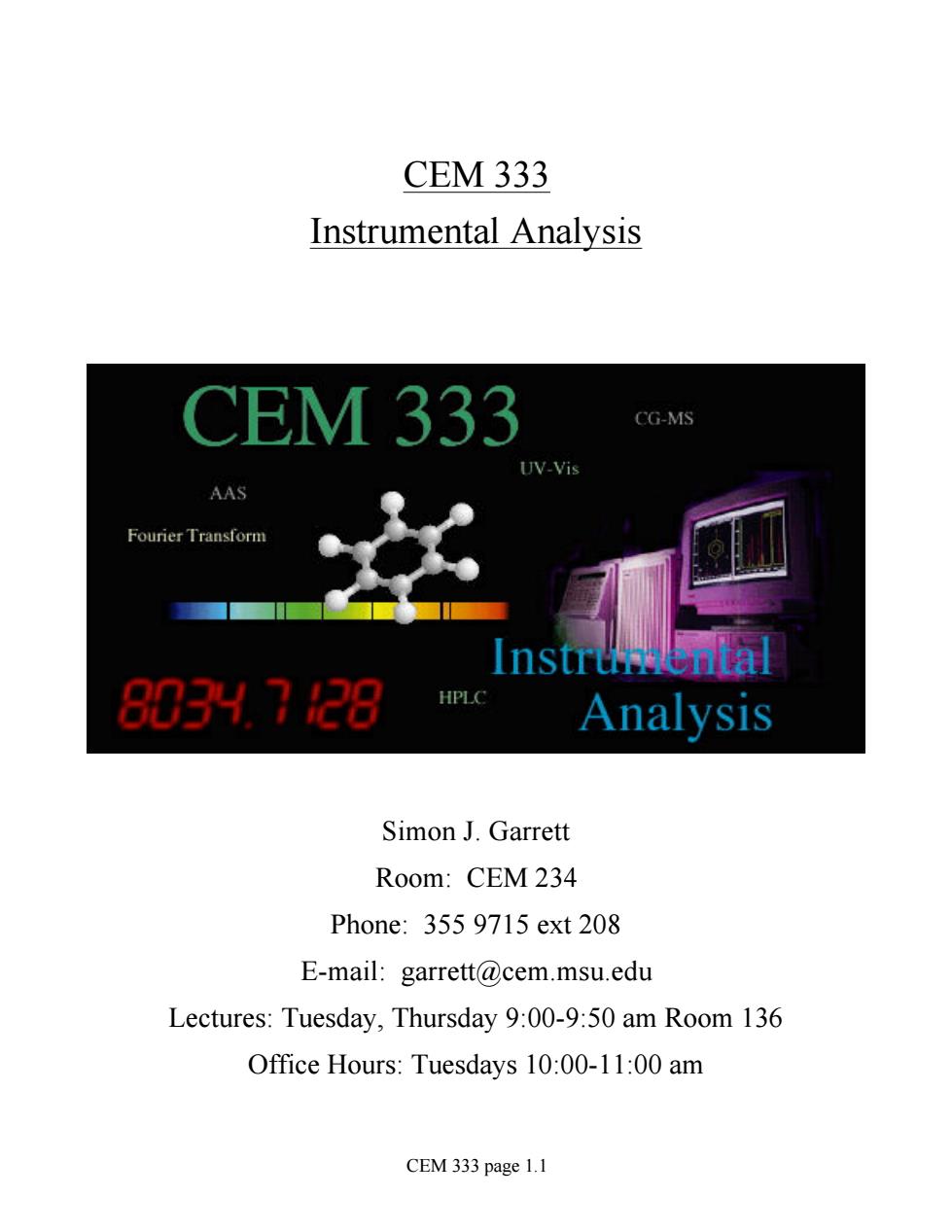
CEM 333 Instrumental Analysis CEM 333 CG-MS UV-Vis AAS Fourier Transform Instruental 803H.728 Analysis Simon J.Garrett Room:CEM 234 Phone:355 9715 ext 208 E-mail:garrett@cem.msu.edu Lectures:Tuesday,Thursday 9:00-9:50 am Room 136 Office Hours:Tuesdays 10:00-11:00 am CEM 333 page 1.1
CEM 333 Instrumental Analysis Simon J. Garrett Room: CEM 234 Phone: 355 9715 ext 208 E-mail: garrett@cem.msu.edu Lectures: Tuesday, Thursday 9:00-9:50 am Room 136 Office Hours: Tuesdays 10:00-11:00 am CEM 333 page 1.1
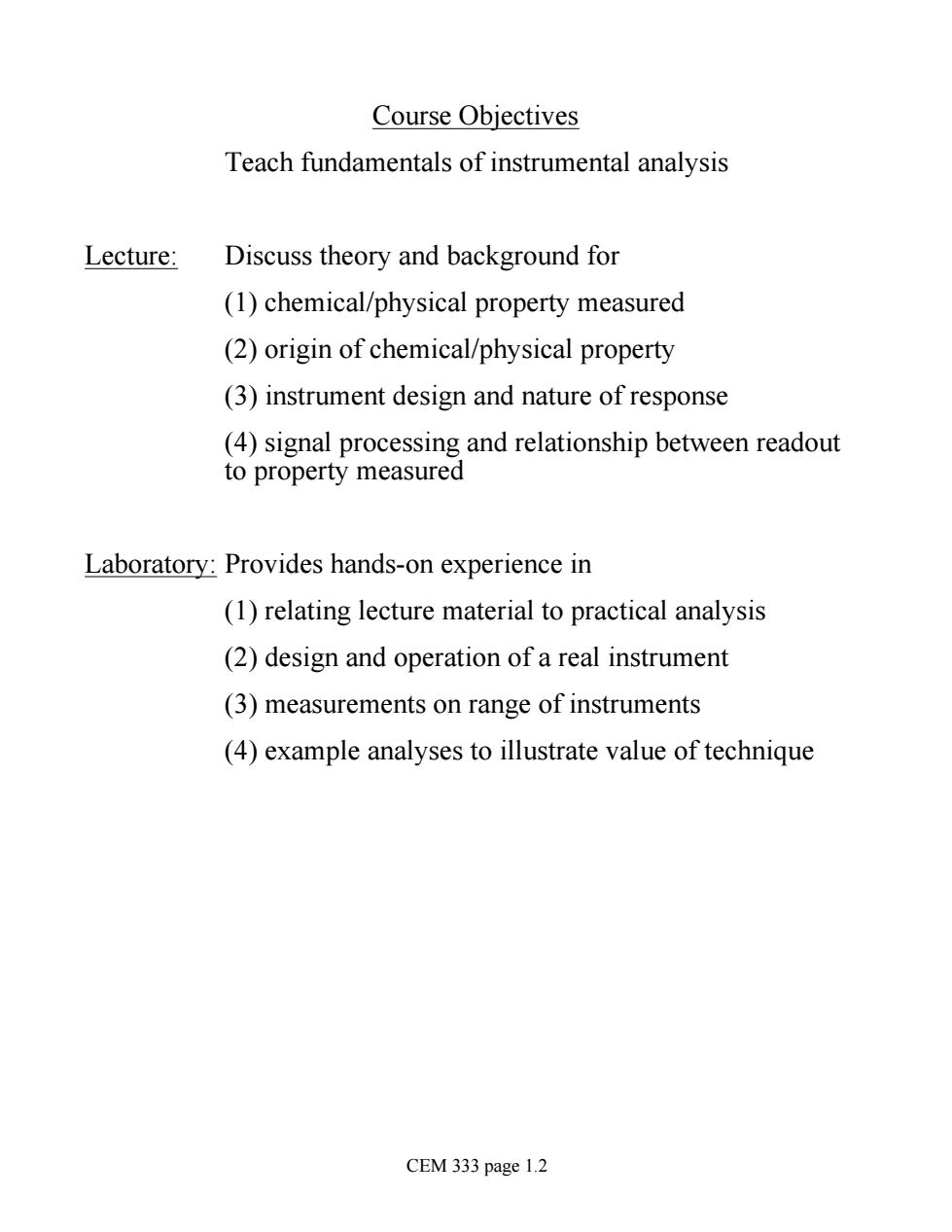
Course Objectives Teach fundamentals of instrumental analysis Lecture: Discuss theory and background for (1)chemical/physical property measured (2)origin of chemical/physical property (3)instrument design and nature of response (4)signal processing and relationship between readout to property measured Laboratory:Provides hands-on experience in (1)relating lecture material to practical analysis (2)design and operation of a real instrument (3)measurements on range of instruments (4)example analyses to illustrate value of technique CEM 333 page 1.2
Course Objectives Teach fundamentals of instrumental analysis Lecture: Discuss theory and background for (1) chemical/physical property measured (2) origin of chemical/physical property (3) instrument design and nature of response (4) signal processing and relationship between readout to property measured Laboratory: Provides hands-on experience in (1) relating lecture material to practical analysis (2) design and operation of a real instrument (3) measurements on range of instruments (4) example analyses to illustrate value of technique CEM 333 page 1.2
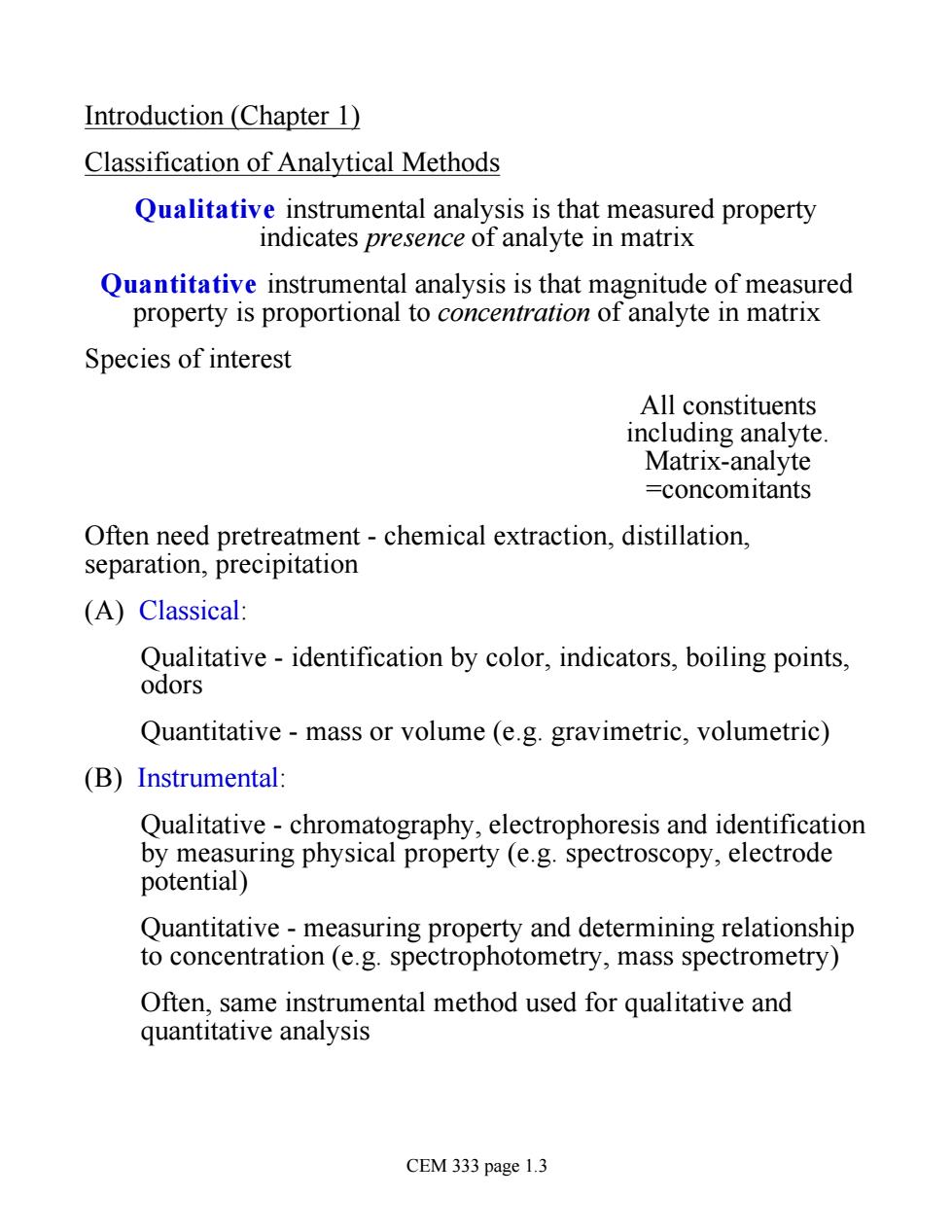
Introduction (Chapter 1) Classification of Analytical Methods Qualitative instrumental analysis is that measured property indicates presence of analyte in matrix Quantitative instrumental analysis is that magnitude of measured property is proportional to concentration of analyte in matrix Species of interest All constituents including analyte Matrix-analyte =concomitants Often need pretreatment-chemical extraction,distillation, separation,precipitation (A)Classical: Qualitative-identification by color,indicators,boiling points, odors Quantitative -mass or volume (e.g.gravimetric,volumetric) (B)Instrumental Qualitative -chromatography,electrophoresis and identification by measuring physical property (e.g.spectroscopy,electrode potential) Quantitative-measuring property and determining relationship to concentration(e.g.spectrophotometry,mass spectrometry) Often,same instrumental method used for qualitative and quantitative analysis CEM 333 page 1.3
Introduction (Chapter 1) Classification of Analytical Methods Qualitative instrumental analysis is that measured property indicates presence of analyte in matrix Quantitative instrumental analysis is that magnitude of measured property is proportional to concentration of analyte in matrix Species of interest All constituents including analyte. Matrix-analyte =concomitants Often need pretreatment - chemical extraction, distillation, separation, precipitation (A) Classical: Qualitative - identification by color, indicators, boiling points, odors Quantitative - mass or volume (e.g. gravimetric, volumetric) (B) Instrumental: Qualitative - chromatography, electrophoresis and identification by measuring physical property (e.g. spectroscopy, electrode potential) Quantitative - measuring property and determining relationship to concentration (e.g. spectrophotometry, mass spectrometry) Often, same instrumental method used for qualitative and quantitative analysis CEM 333 page 1.3
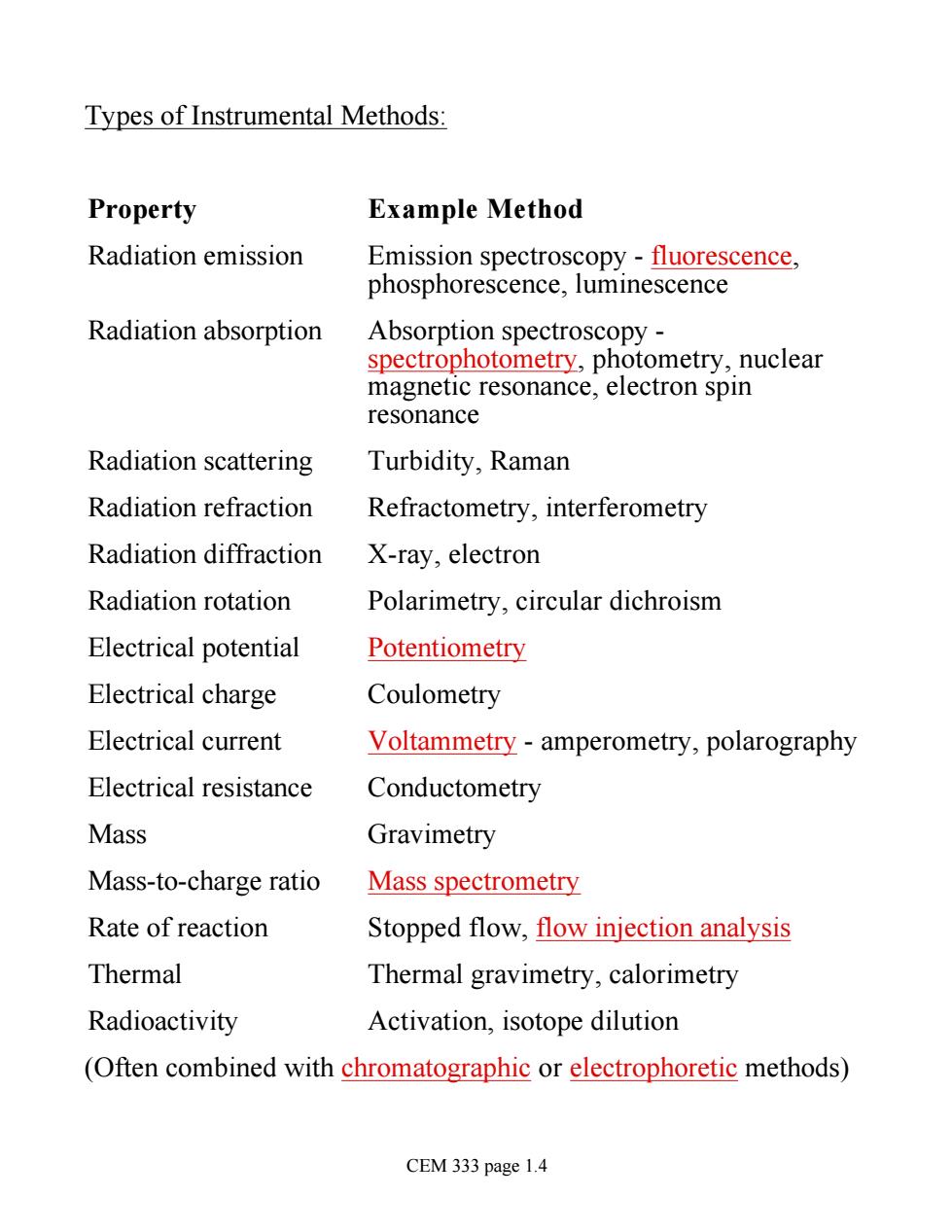
Types of Instrumental Methods: Property Example Method Radiation emission Emission spectroscopy -fluorescence, phosphorescence,luminescence Radiation absorption Absorption spectroscopy spectrophotometry,photometry,nuclear magnetic resonance,electron spin resonance Radiation scattering Turbidity,Raman Radiation refraction Refractometry,interferometry Radiation diffraction X-ray,electron Radiation rotation Polarimetry,circular dichroism Electrical potential Potentiometry Electrical charge Coulometry Electrical current Voltammetry-amperometry,polarography Electrical resistance Conductometry Mass Gravimetry Mass-to-charge ratio Mass spectrometry Rate of reaction Stopped flow,flow injection analysis Thermal Thermal gravimetry,calorimetry Radioactivity Activation,isotope dilution (Often combined with chromatographic or electrophoretic methods) CEM 333 page 1.4
Types of Instrumental Methods: Property Example Method Radiation emission Emission spectroscopy - fluorescence, phosphorescence, luminescence Radiation absorption Absorption spectroscopy - spectrophotometry, photometry, nuclear magnetic resonance, electron spin resonance Radiation scattering Turbidity, Raman Radiation refraction Refractometry, interferometry Radiation diffraction X-ray, electron Radiation rotation Polarimetry, circular dichroism Electrical potential Potentiometry Electrical charge Coulometry Electrical current Voltammetry - amperometry, polarography Electrical resistance Conductometry Mass Gravimetry Mass-to-charge ratio Mass spectrometry Rate of reaction Stopped flow, flow injection analysis Thermal Thermal gravimetry, calorimetry Radioactivity Activation, isotope dilution (Often combined with chromatographic or electrophoretic methods) CEM 333 page 1.4
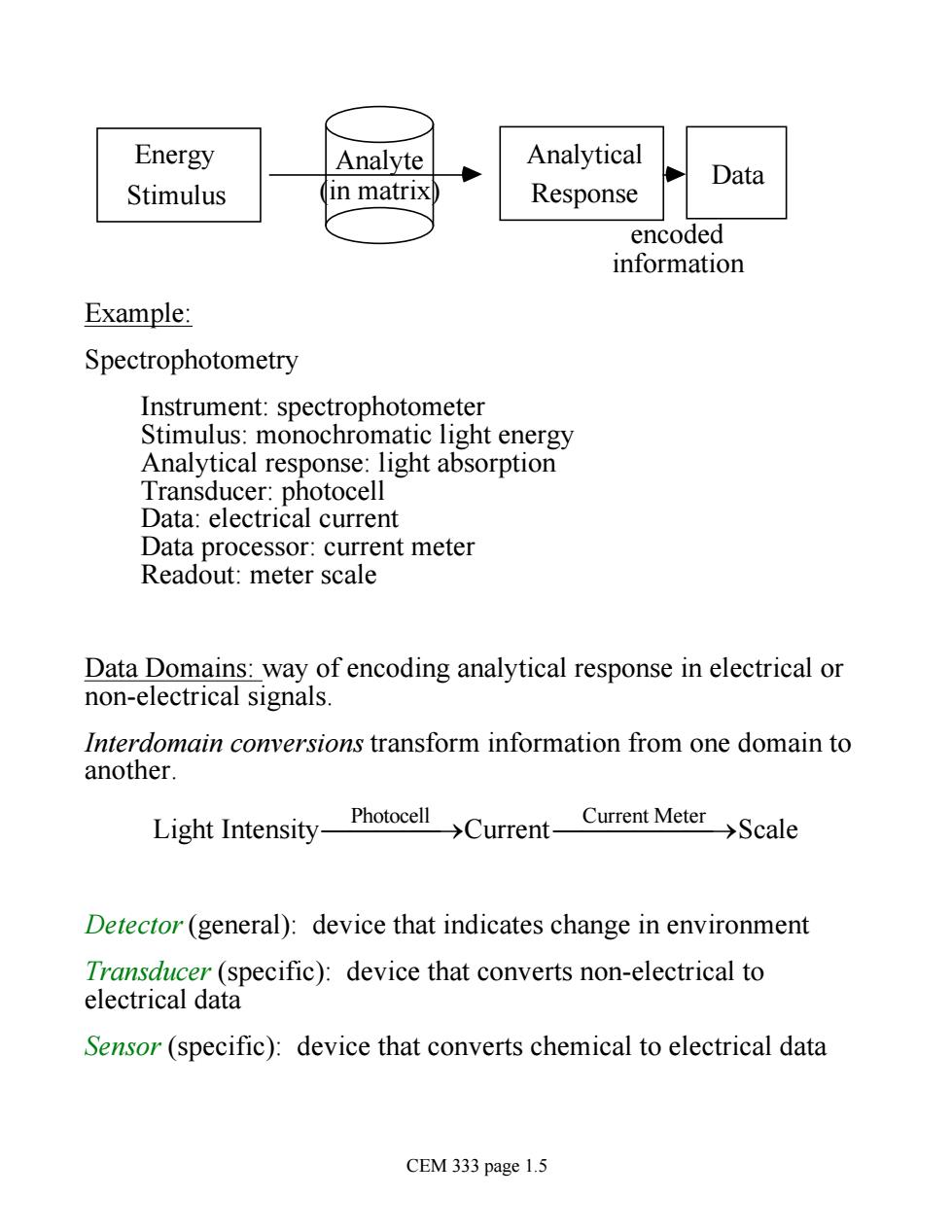
Energy Analyte Analytical Data Stimulus in matrix) Response encoded information Example: Spectrophotometry Instrument:spectrophotometer Stimulus:monochromatic light energy Analytical response:light absorption Transducer:photocell Data:electrical current Data processor:current meter Readout:meter scale Data Domains:way of encoding analytical response in electrical or non-electrical signals. Interdomain conversions transform information from one domain to another. Light Intensity-Photocell >Current Current Metercae Detector(general):device that indicates change in environment Transducer (specific):device that converts non-electrical to electrical data Sensor(specific):device that converts chemical to electrical data CEM 333 page 1.5
Stimulus Response Analyte (in matrix) Energy Analytical Data encoded information Example: Spectrophotometry Instrument: spectrophotometer Stimulus: monochromatic light energy Analytical response: light absorption Transducer: photocell Data: electrical current Data processor: current meter Readout: meter scale Data Domains: way of encoding analytical response in electrical or non-electrical signals. Interdomain conversions transform information from one domain to another. Light Intensity Photocell ¾ ¾ ¾ ¾ ¾ ® Current Current Meter ¾ ¾ ¾ ¾ ¾ ¾ ® Scale Detector (general): device that indicates change in environment Transducer (specific): device that converts non-electrical to electrical data Sensor (specific): device that converts chemical to electrical data CEM 333 page 1.5

Non-Electrical Domains Electrical Domains Physical (light intensity,color) Current Chemical (pH) Voltage Scale Position (length) Charge Number (objects) Frequency Pulse width Phase Count Serial Parallel Time-vary with time(frequency,phase,pulse width) Analog-continuously variable magnitude(current,voltage,charge) Digital -discrete values (count,serial,parallel,number*) CEM 333 page 1.6
Non-Electrical Domains Electrical Domains Physical (light intensity, color) Current Chemical (pH) Voltage Scale Position (length) Charge Number (objects) Frequency Pulse width Phase Count Serial Parallel Time - vary with time (frequency, phase, pulse width) Analog - continuously variable magnitude (current, voltage, charge) Digital - discrete values (count, serial, parallel, number*) CEM 333 page 1.6

Digital Binary Data Advantages (1)easy to store(2)not susceptible to noise 4th bit 3rd bit 2nd bit 1st bit Hi Count Lo Hi Serial Lo Hi 30 品 3 separate signals Parallel Lo 23 20=1,21=2,22=4. CEM 333 page 1.7
Digital Binary Data Advantages (1) easy to store (2) not susceptible to noise 2 2 4th bit 3rd bit 2nd bit 1st bit Hi Lo Count Serial 2 0 2 1 2 0 2 1 2 2 Parallel Hi Lo Hi Lo Hi Lo Hi Lo 3 separate signals 20=1, 21=2, 22=4. CEM 333 page 1.7

Performance Characteristics:Figures of Merit How to choose an analytical method?How good is measurement? How reproducible?-Precision How close to true value?-Accuracy/Bias How small a difference can be measured?-Sensitivity What range of amounts?-Dynamic Range How much interference?-Selectivity CEM 333 page 1.8
Performance Characteristics: Figures of Merit How to choose an analytical method? How good is measurement? How reproducible? - Precision How close to true value? - Accuracy/Bias How small a difference can be measured? - Sensitivity What range of amounts? - Dynamic Range How much interference? - Selectivity CEM 333 page 1.8

Precision-Indeterminate or random errors i=N (x-x)2 Absolute standard deviation:s= N-1 Variance:s2 Relative standard deviation:RSD=S Standard deviation of mean:sm= √N Accuracy -Determinate errors (operator,method,instrumental) Bias:bias =X-Xtrue Sensitivity S=dSignal Calibration sensitivity: dc c+Signal blank mc+Signal blank (larger slope of calibration curve m,more sensitive measurement) Detection Limit Signal must be bigger than random noise of blank Minimum signal:Signal min =Av.Signal blank +ksplank From statistics k=3 or more (at 95%confidence level) CEM 333 page 1.9
Precision - Indeterminate or random errors Absolute standard deviation: s = xi ( - x ) 2 i-0 i= N å N -1 Variance: s 2 Relative standard deviation: RSD = s x Standard deviation of mean: sm = s N Accuracy - Determinate errors (operator, method, instrumental) Bias: bias = x - xtrue Sensitivity Calibration sensitivity: S = dSignal dc c + Signal blank = mc + Signal blank (larger slope of calibration curve m, more sensitive measurement) Detection Limit Signal must be bigger than random noise of blank Minimum signal: Signal min = Av. Signal blank + ksblank From statistics k=3 or more (at 95% confidence level) CEM 333 page 1.9

Dynamic Range At detection limit we can say confidently analyte is present but cannot perform reliable quantitation Level of quantitation (LOQ):k=10 Limit of linearity (LOL):when signal is no longer proportional to concentration LOL Dynamic range 102to>106 LOQ Selectivity: No analytical method is completely free from interference by concomitants.Best method is more sensitive to analyte than interfering species (interferent). Matrix with species A&B:Signal =mAcA +mBcB+Signal blank mB Selectivity coefficient:kB.A= m A k's vary between 0(no selectivity)and large number(very selective). CEM 333 page 1.10
Dynamic Range At detection limit we can say confidently analyte is present but cannot perform reliable quantitation Level of quantitation (LOQ): k=10 Limit of linearity (LOL): when signal is no longer proportional to concentration Dynamic range: LOL LOQ 102 to > 106 Selectivity: No analytical method is completely free from interference by concomitants. Best method is more sensitive to analyte than interfering species (interferent). Matrix with species A&B: Signal = mAcA + mBcB + Signal blank Selectivity coefficient: kB,A = mB mA k's vary between 0 (no selectivity) and large number (very selective). CEM 333 page 1.10